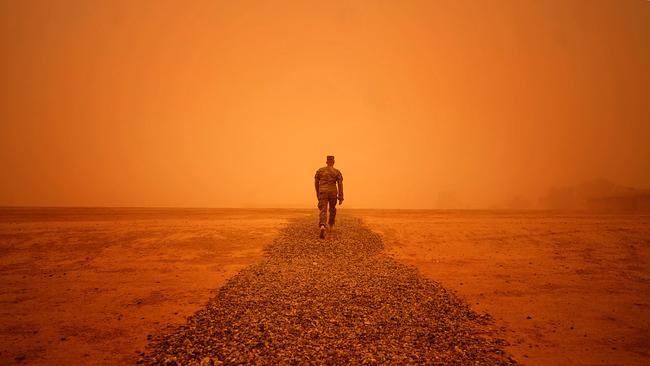War in Afghanistan: A forever and fateful failure
The US operation to kick Saddam Hussein out of Kuwait in 1990 showed China the vastness of America’s technological superiority.

“It was a result of muddled thinking, a lack of clear purposes. The project in Afghanistan morphed from disrupting al-Qa’ida to rebuilding Afghanistan in the image of ourselves without regard to geography or culture. We never had a relationship of accountability with the Afghan people. A week after I left Afghanistan in 2013 the vast majority of the leaders we were training were killed in a suicide mission.”
— Andrew Hastie, now Assistant Defence Minister, in an interview in 2017
-
The 20-year war in Afghanistan has been a civilisational failure for the West. It is not Australia’s most expensive war. We suffered 41 combat deaths, which is a grievous and terrible burden on the families and loved ones of those brave Australians who died. But strategically, the Afghanistan war will have profound effects on Australia, many of them negative, and some of them positive.
For the US, Afghanistan and Iraq must be grouped together, and together they have had a terrible effect on America.
The failure has not been total. Significant good was done in both countries, but the duration of the mission, the cost in Afghani, Iraqi and coalition lives, and the cost in money and strategic distortion, were far beyond any good that was achieved.
The biggest operational cost, and the one which may ultimately have the greatest impact on Australia, was to distort the force structure and priorities of the US military. It spent 20 years giving away its technological lead and concentrating on ground wars in the Middle East, as a result neglecting the burgeoning challenge of China and the need for new capabilities in the Indo-Pacific.
Even the new US Defence Secretary Lloyd Austin, formidable and admirable man that he is, comes from a Middle East land warfare background, whereas the overriding challenge for the US is maritime capability in Asia, as well as cyber and space capabilities, and the new frontiers of military technology — from hypersonic weapons to artificial intelligence — none of which was very relevant in Iraq and Afghanistan.
In both cases, the initial military intervention was justified. In both cases, the post-conflict management was awful.
The Afghanistan war has cost America $US2 trillion. More than 2300 American soldiers have died in Afghanistan, and more than 20,000 were wounded.
US, NATO and Australian leaders commented from time to time on the giant coalition, the greatest coalition in history, assembled to defeat al-Qa’ida, rout the Taliban and help the Afghans establish a durable government.
There are now officially 2500 US troops in Afghanistan, and a few hundred more defence contractors, CIA personnel, counter-terrorism officers and others. There are about 7000 other NATO troops and 80 Australians.
US President Joe Biden has declared that by September 11, the 20th anniversary of the al-Qa’ida terror attacks in the US, all the American soldiers, except perhaps a small number to protect US diplomats, will be gone.

While I support Biden’s basic decision to pull the troops out, nominating the anniversary of the terror attacks as the date for withdrawal must rank as one of the most bizarre, inexplicable, grotesque and self-harming acts of symbolism by any modern US president. The very last thing Biden should do is turn this into a US-given victory lap for a terrorist triumph of the will over American staying power. Orderly withdrawal and strategic recalibration is one thing. Offering pure free propaganda victories to your deadly enemies is unfathomable.
As a result of American withdrawal, all other coalition forces will also leave. Scott Morrison has confirmed the last Australians will be coming home too.
The initial mission was to destroy the al-Qa’ida base in Afghanistan, punish and remove the Taliban government for hosting al-Qa’ida, prevent Afghanistan from doing so in the future, and capture Osama bin Laden. The longer-term strategic aim was to create a self-sustaining Afghan government that would observe basic human rights and not co-operate with terrorists.
So after 20 years, how has the West gone? The result, frankly, is dismal. The Taliban were unseated from government but are stronger now than they’ve ever been as a widespread movement enjoying a great deal of support. Al-Qa’ida is active in several provinces and has run training camps and some operations in Afghanistan. Islamic State has a small presence in the country.
All this might be an argument for the US staying even longer. Peter Jennings, the director of the Australian Strategic Policy Institute, is the most eloquent proponent of the idea that a small US garrison of 2500 troops is an affordable commitment in keeping Afghanistan stable. This is a respectable view.
But of course the American military and civilian leaders have never really been quite honest about such a commitment. They have always presented Afghanistan as a war to be won, a government to be helped in its initial stages of consolidation, not as a permanent presence.
After 20 years, permanent presence achieved by endless temporary extension just doesn’t work any longer, either politically or militarily. Apart from anything else, no US president has ever had a mandate for a permanent presence in Afghanistan. Biden was surely right to declare: “We cannot continue the cycle of extending or expanding our presence in Afghanistan, hoping to create ideal conditions for withdrawal, and expecting a different result.”
The US dominance in Afghanistan has led to welcome social advances. There are more girls at school than ever in Afghanistan’s history. There is an emerging middle class. Afghanistan is more connected to international influences, global trends in culture and human dialogue than at any time perhaps in its modern history.
But all that at its crudest simply shows that an Afghanistan run by the Americans will be a much better place for a large number of people than an Afghanistan run by the Taliban. These social advances will be meaningless unless they can be sustained under a long-term Afghan government.
In terms of keeping al-Qa’ida at bay, which was the initial purpose of intervention, it is analytically absurd to imagine the only way this could be done is through a multi-trillion dollar military investment over two decades. In the Diary of a Foreign Minister, Bob Carr records a conversation about Afghanistan with senior Australian people. Quite rightly Carr does not identify the agency involved, but we can guess that the Australian Secret Intelligence Service would have been involved in Afghanistan affairs when so many Australians were deployed there and it was a centre of global terrorism.
Carr reports the conversation, on May 12, 2013, this way: “… a discussion with senior people about Afghanistan. They agree that, after 12 years, the whole war has been a waste. The Taliban is laughing. Said one of them, who had been there twice a year over the last ten: ‘We spent a billion dollars in Uruzgun province. It has a population of just over 300,000. We could have achieved the same result if I’d been sent up there with $10 million to distribute bribes.’ ”
This is a tough judgment and may involve some exaggeration. But it echoes what many security professionals believe. Like many supporters of the US alliance system, I supported the initial military intervention in Afghanistan and the Australian role in it. But America betrayed the integrity of its justified initial military operations in both Afghanistan and Iraq by the incompetence and counter-productive nature of its post-conflict operations — the occupation in Iraq and the semi-occupation in Afghanistan.
Just before the US invasion of Iraq, I had a long conversation with Henry Kissinger. He remarked, quite forcefully, that it was vital the US straight away set up a provisional Iraqi government and hand over authority to it. He thought it would be politically and geostrategically disastrous to have America occupying a key Arab nation.
The US operations in Iraq and Afghanistan did not reflect American malice or an empire-building instinct. Rather, they reflected American overconfidence and, in a sense, an over-generosity — a desire in both cases to leave something behind for the Iraqi and Afghan peoples that was much better than what they found.
This ambition proved comprehensively beyond the Americans and their allies, including Australia. And it nearly broke the US Army and Marines, just as, on a smaller scale, our massive overuse of the special forces in Afghanistan nearly broke their culture.
Iraq was a bigger drain on the Americans than Afghanistan, but they were both enormously costly — 10 years ago, the US had 100,000 troops in Afghanistan, the cost of which, in terms of distorting US military priorities and force structure, was immense. It may be the single most important strategic result of the Afghan and Iraq wars.
There is a pretty well universal “rule of three” in military deployments. If you have 100,000 troops in Afghanistan, that also means you’ve got another 100,000 recently back from deployment, and yet another 100,000 training and getting ready to go there.
All through the 20 years of the endless Afghan and Iraq wars, the successive US Pacific commanders were crying out for resources, watching the US Navy shrink to levels that were previously declared unacceptable. But the US Pacific commanders were competing for resources with the US Middle East commanders, who were fighting wars. Who do you think wins that argument?
The US operation to kick Saddam Hussein out of Kuwait way back in 1990 had shown the Chinese how vast was America’s technological superiority. From then on, Beijing changed its own military doctrine — which, like many Asian militaries, had previously been inward looking and focused on securing its territory internally — to an outward focus and a determined effort to catch up with the US technologically.
The Americans were so far ahead technologically that this looked completely impossible. There was a later term, “the revolution in military affairs”, which described the unique US ability to apply information technology to warfare. But when Afghanistan and Iraq got going, the whole US strategic class drank the KoolAid of counter-insurgency. RMA was replaced by COIN.
But to be remotely effective, counter-insurgency must be waged by local forces and almost never is effective against an entire ethnic group, such as the southern Pashtuns who have never been reconciled to the central Afghan government. This is made even more impossible if the insurgents have a neighbouring territory to flee to whenever they are under too much pressure — as the Taliban effectively had in parts of Pakistan.
Now, the way Biden supports Afghanistan after the American withdrawal is critical. The Afghan government, knowing the Americans will not come back, will have a high degree of motivation to fight to survive. But it will need three things: money to pay its troops; logistic support to move supplies around the country; and air power to strike targeted enemies and to prevent the Taliban, or anyone else, massing the kind of force needed to take a city.
The danger is the Afghan operation has become so unpopular the Americans will be reluctant to do even that much. But that is exactly the sort of model they should have been following for years.
Meanwhile, for Washington to seriously focus its attention, and its resources, on the Indo-Pacific — as the Biden administration shows every indication of doing — is very welcome.



To join the conversation, please log in. Don't have an account? Register
Join the conversation, you are commenting as Logout